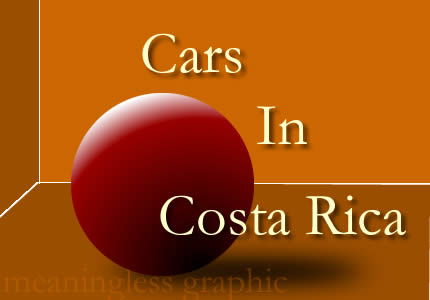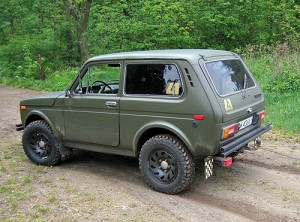When we foreigners first hear about the amazingly high tax rate on cars, we are shocked and wonder at how can that be? This is lunacy! There must be some way around it.

First off: there is no way around it, and as for the lunacy part, perhaps. But there is a rather twisted sort of logic that I’ll go into later that may help to explain this.
What kind of car to own?
In 1999, when I first moved to Costa Rica, the world was a very different place. Not many Ticos had cars and those that did were driving cars that were considered classics by Gringo standards. I was a bit surprised to see a number of Datsuns on the road. Remember those?
I discovered that Costa Rica is extremely hard on cars. So, whatever car you see a lot of here, that car is likely a very good, very well-built car. The hot tickets were the late ‘70s Toyota Land Cruisers and Land Rover Defenders. They were all over the place – and diesel no less! These cars in the States go for a pretty penny. Here, they are not so much fashionable, as reliable and affordable.
My first car in Costa Rica was a 1978 Diesel Toyota Land Cruiser. Every grown up boy’s dream. I LOVED it. My kids didn’t like it due to the rough ride and the sideways facing rear seats. So we ended up getting rid of it and getting an early ‘90s Isuzu Trooper, another of the immortal cars at the time.
So, back then, at the beginning of my Costa Rica saga, the amazing cars were:
- Toyota Land Cruisers old & new
- Land Rover Defender (old)
- Toyota 4Runners
- Isuzu Trooper
- Mitsubishi Montero
- Suzuki Samurai
- Niva

The Niva was an interesting car. It is from Russia and was built like a little coupe, but it was/is 4 wheel drive. I had some Tico friends that had one and they loved it. I looked it up on the Internet and saw that there was some serious fever around this little car. There were clubs and some very souped up examples of the little vehicle around the country.
Now
I drive a 1998 Toyota 4Runner and I love it. I am VERY hard on it, and it just purrs right along. This body style and 3.0 turbo diesel motor are a genuine classic here in Costa Rica, and you see lots of these cars around. Toyota continued this particular model until 2002. So, if I were to upgrade my Toyota, it would be for a 2002, but the problem is, I am quite happy with it the one I have now. I spent $16,000 on it 3 years ago. I am told that it would fetch $16,000 now. I have a hard time believing that, but a quick check of what they are getting for them at crautos.com confirms that it has held its value very well.
I’m also a fan of the Suzuki Gran Vitara. I don’t know if this car exists in the States, but here it is a long lived car, and so its presence is felt on the roads of Costa Rica. Concerns are: gas only, a little low on ground clearance.
The Mitsubishi Montero is a great SUV. There are 2 models, a Sport model and a larger, more deluxe model. Both are good, but my preference still leans towards the 4Runner, mainly due to the larger 3.0 motor. Although, you can get a 3.5 in the larger Mistubishi, but then you are in another price bracket. Good clearance, stout, diesel.
Other popular makes & models are: Toyota Prado – very popular, most Nissan SUVs, Daihatsu BeGo is a small 4 wheel drive that is immensely popular. Jury is still out on durability. I know that the back door starts to rattle almost immediately, but with their short wheel base, they seem to go anywhere. The smaller 4 wheel drive cars feel every bump in the road.
Samurai’s and Sidekicks hold a strong place in the mix.
You still see some of the older Landcruisers and Defenders around, but they are getting so old, and so beat up here in the Costa Rican life style that they are now starting to suffer from material fatigue. They seem to want to keep running, but even the raw material of the chassis is getting tired out. Still, there are some good examples around and you can have a lot of fun fixing one of these up. I know of one right now for sale by my neighbor for $4,000, which I think is a decent example of their street value. Its in good condition and runs well.
Cars are the largest single expense in the Costa Rican lifestyle. Gas is running over $5.00 per gallon, and those taxes make just the buying of them painful, if not prohibitive.
Ridiculous Taxes Justified
So how is it that the high tax isn’t absolute lunacy? The government of Costa Rica is saddled by an interesting challenge. The land in the country has just recently, say in the last 15 years, started to have a value. Up until then, all Ticos had land, land they didn’t have to pay for. For the most part, it was free!
Now people from all around the world are wanting some land in Costa Rica, so obviously the values on Costa Rica real estate have gone up. However, the government does not have the ability to raise the taxes on the land since this would impact a good sized majority of land owners in Costa Rica – subsistence farmers. So, I think without saying as much, and perhaps without even consciously recognizing that it’s what they do, they set out to tax the rich, and leave the poor alone. This is done by high vehicle taxes, with exceptions being extended to common types of farm vehicles.
The government is now starting to look at other ways to tax the rich. They are working on tax maps that will assign a tax value particular to certain areas ie. coastal areas would be taxed higher than inland farm territories and so on.
If you’d like to post your thoughts on cars in Costa Rica, please feel free to do so.